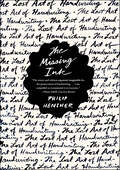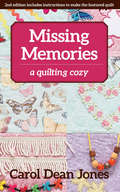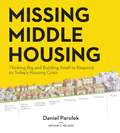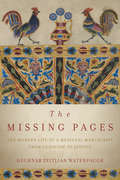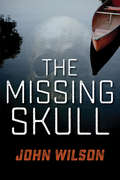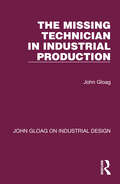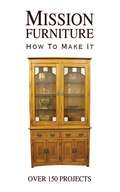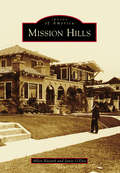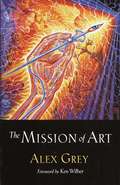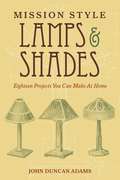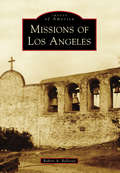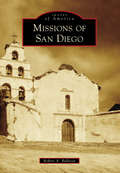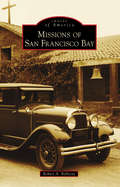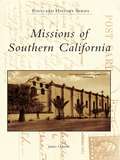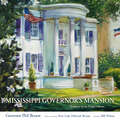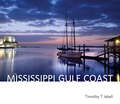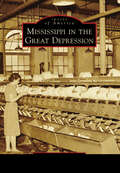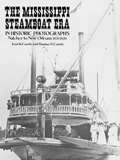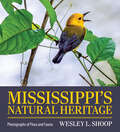- Table View
- List View
**Missing**: Staging Motherhood in 21st Century North American Theatre & Performance (Routledge Advances in Theatre & Performance Studies)
by Aoise StratfordThis anthology examines maternity in contemporary performance at the intersection of a wide range of topics from nationhood to mental health, queer parenting, embodied dramaturgy, cultural practice, and immigration. Across the breadth of these themes, we interrogate the cultural implications and politics of how we script, perform, receive, and define mothers, challenging many of the normalizing and patriarchal tropes associated with the mother-as-character. This book includes critical essays examining twenty-first century dramatic literature, first-hand ethnographic accounts of motherhood in practice, interviews, feminist manifestos, and artist reflections. In its deliberately curated variety, this collection seeks to resist homogeneity and offer instead a range of approaches to key questions: what versions of motherhood get staged, and why? And how do dramatic representations tell us about the role of mothers in our own fraught contemporary moment? This collection will be of great interest to those in academia who are teaching, researching, or studying in the fields of Theatre and Performance Studies, American Studies, and Feminist and Gender Studies.
The Missing Ink: The Lost Art of Handwriting
by Philip HensherWhen Philip Hensher realized that he didn't know what a close friend's handwriting looked like ("bold or crabbed, sloping or upright, italic or rounded, elegant or slapdash"), he felt that something essential was missing from their friendship. It dawned on him that having abandoned pen and paper for keyboards, we have lost one of the ways by which we come to recognize and know another person. People have written by hand for thousands of years— how, Hensher wondered, have they learned this skill, and what part has it played in their lives? The Missing Ink tells the story of this endangered art. Hensher introduces us to the nineteenth-century handwriting evangelists who traveled across America to convert the masses to the moral worth of copperplate script; he examines the role handwriting plays in the novels of Charles Dickens; he investigates the claims made by the practitioners of graphology that penmanship can reveal personality.But this is also a celebration of the physical act of writing: the treasured fountain pens, chewable ballpoints, and personal embellishments that we stand to lose. Hensher pays tribute to the warmth and personality of the handwritten love note, postcards sent home, and daily diary entries. With the teaching of handwriting now required in only five states and many expert typists barely able to hold a pen, the future of handwriting is in jeopardy. Or is it? Hugely entertaining, witty, and thought-provoking, The Missing Ink will inspire readers to pick up a pen and write.
The Missing Link: From Basic to Beautiful Wirework Jewelry
by Cindy WimmerExplore the most fundamental and versatile--yet overlooked--component of jewelry design-the wire link! Unlike many transient jewelry fads, it is one aspect of jewelry making that is consistent and relevant to nearly every style. Get all the details of essential tools and wire techniques as well as a collection of 30 custom links and step-by-step illustrated instructions for creating them. Join a variety of contributors that have created 15 jewelry projects, each incorporating one or more of author Cindy Wimmer's links. You'll see how any single link holds limitless design and functional possibilities. In addition to creating different links, Cindy will show you how to create different effects with the same link design by using or combining different colored wire, changing wire gauge, or changing the size of the link itself.
Missing Memories: A Quilting Cozy (A\quilting Cozy Ser. #8)
by Carol Dean JonesAn amateur detective in a retirement community looks into a mysterious disappearance—includes instructions for a memory quilt! Moving into the Cunningham Village retirement community was an adjustment, but Sarah Miller is a survivor, and she&’s made a whole new life for herself there—new friends, new hobbies, and even new love after mourning the loss of her husband. She also seems to have acquired a new knack for solving crimes. Now, just as she plunges into a project making memory quilts for Alzheimer&’s patients, one of Sarah&’s friends has gone missing—and she&’s being told to leave the case to the professionals. But Sarah intends to put the pieces together and sew up this mystery…
Missing Middle Housing: Thinking Big and Building Small to Respond to Today's Housing Crisis
by Daniel G. ParolekToday, there is a tremendous mismatch between the available housing stock in the US and the housing options that people want and need. The post-WWII, auto-centric, single-family-development model no longer meets the needs of residents. Urban areas in the US are experiencing dramatically shifting household and cultural demographics and a growing demand for walkable urban living. Missing Middle Housing, a term coined by Daniel Parolek, describes the walkable, desirable, yet attainable housing that many people across the country are struggling to find. Missing Middle Housing types—such as duplexes, fourplexes, and bungalow courts—can provide options along a spectrum of affordability. In Missing Middle Housing, Parolek, an architect and urban designer, illustrates the power of these housing types to meet today's diverse housing needs. With the benefit of beautiful full-color graphics, Parolek goes into depth about the benefits and qualities of Missing Middle Housing. The book demonstrates why more developers should be building Missing Middle Housing and defines the barriers cities need to remove to enable it to be built. Case studies of built projects show what is possible, from the Prairie Queen Neighborhood in Omaha, Nebraska to the Sonoma Wildfire Cottages, in California. A chapter from urban scholar Arthur C. Nelson uses data analysis to highlight the urgency to deliver Missing Middle Housing. Parolek proves that density is too blunt of an instrument to effectively regulate for twenty-first-century housing needs. Complete industries and systems will have to be rethought to help deliver the broad range of Missing Middle Housing needed to meet the demand, as this book shows. Whether you are a planner, architect, builder, or city leader, Missing Middle Housing will help you think differently about how to address housing needs for today's communities.
The Missing Pages: The Modern Life of a Medieval Manuscript, from Genocide to Justice
by Heghnar Zeitlian WatenpaughIn 2010, the world's wealthiest art institution, the J. Paul Getty Museum, found itself confronted by a century-old genocide. The Armenian Church was suing for the return of eight pages from the Zeytun Gospels, a manuscript illuminated by the greatest medieval Armenian artist, Toros Roslin. Protected for centuries in a remote church, the holy manuscript had followed the waves of displaced people exterminated during the Armenian genocide. Passed from hand to hand, caught in the confusion and brutality of the First World War, it was cleaved in two. Decades later, the manuscript found its way to the Republic of Armenia, while its missing eight pages came to the Getty. The Missing Pages is the biography of a manuscript that is at once art, sacred object, and cultural heritage. Its tale mirrors the story of its scattered community as Armenians have struggled to redefine themselves after genocide and in the absence of a homeland. Heghnar Zeitlian Watenpaugh follows in the manuscript's footsteps through seven centuries, from medieval Armenia to the killing fields of 1915 Anatolia, the refugee camps of Aleppo, Ellis Island, and Soviet Armenia, and ultimately to a Los Angeles courtroom. Reconstructing the path of the pages, Watenpaugh uncovers the rich tapestry of an extraordinary artwork and the people touched by it. At once a story of genocide and survival, of unimaginable loss and resilience, The Missing Pages captures the human costs of war and persuasively makes the case for a human right to art.
Missing Skull, The (The Seven Prequels)
by John WilsonA trip to a remote lake in northern Ontario with his grandfather doesn't thrill Steve, especially since his twin brother, DJ, was taken to Central America. Matters start to look up when his grandfather tells Steve about the mysterious death of the artist Tom Thomson and sets him the task of finding Thomson's missing skull. Steve loves mysteries, but when odd things begin happening and strange people start threatening him, Steve wonders whether this is part of his grandfather's plan. Is this still a simple puzzle, or is something far more sinister going on? In this thrilling prequel to Lost Cause and Broken Arrow, the history- and mystery-loving Steve ends up in remote northern Ontario.
The Missing Technician in Industrial Production (John Gloag On Industrial Design Ser.)
by John GloagOriginally published in 1944, The Missing Technician shows how Industrial Design must begin at the very first stages of planning a product. The procedure of a design research committee is outlined – a type of practical co-ordination of the work of industrial designers and production technicians which proved highly effective. The value of materials like aluminium and plastic are emphasized, but equally the importance of glass and cast iron is stressed, especially when handled in new ways that 20th Century techniques made possible.
Mission Furniture: How to Make It
by H. H. WindsorMission style has withstood the test of time. In homes across America and around the world, Mission furniture creates a look and feel to a home that few others styles can-elegant and homey, all at once. This is a classic book of Mission-style furniture, filled with plans for the do-it-yourselfer and inspiration for architects and designers. Included are chairs, tables, desks, beds, shelves, and other more unusual items like wastepaper baskets, clocks, music stands, and even a porch swing. Each project includes a cutting list and detailed, measured drawings of each furniture piece, as well as the general order of work along with handy finishing tips.
Mission Hills
by Janet O'Dea Allen HazardSeveral visionaries shaped the character that defines present-day Mission Hills. First, there was Sarah Miller, stepdaughter of Captain Johnston of the SS Orizaba. She inherited land from him and built a dream home overlooking Old Town and the Pacific Ocean. There was also Kate Sessions, the mother of Balboa Park, whose nursery growing grounds just outside the original Mission Hills subdivision proved difficult for her clientele to traverse, leading her to convince transportation mogul John D. Spreckles to expand the streetcar route to accommodate her business. In 1905, George Marston, a San Diego civic leader, commissioned landscape architect and urban planner John Nolan to implement a development plan for the city. Nolan's plan, however, was never adopted. In 1908, as if to prove what was possible, Marston's syndicate formed the restricted subdivision of Mission Hills. Then, in 1909, the city announced plans to celebrate the opening of the Panama Canal. The fuse was lit, and the boom that followed brought builders and skilled artisans to San Diego. As a result, Mission Hills became architecturally magnificent.
The Mission of Art
by Alex Grey Ken WilberThis is an inspirational book about art's power to bring about personal catharsis and spiritual awakening. Alex Grey's reflections combine his extensive knowledge of art history and his own first-hand experiences in creating art on the boundaries of consciousness. Included are practical techniques and exercises that can be used to explore the spiritual dimension of art. Challenging and thought-provoking, The Mission of Art will be enjoyed by everyone who has ever contemplated the deeper purpose of artistic expression.
Mission Style Lamps and Shades: Eighteen Projects You Can Make at Home
by John Duncan AdamsWith its simple, organic charm and timeless natural beauty, Mission-style furniture has enjoyed continued popularity for over a century. For craftsman and non-craftsman alike, perhaps the most cherished examples of Mission-style furniture are lamps. Mission Style Lamps and Shades takes readers through the entire process of designing, planning, and constructing radiant Mission-style lamps and shades. For countless craftspeople, John Duncan Adam’s Mission Style Lamps and Shades has been the go-to guide for those wanting to build their own lamps and shades. The book contains a wide array of do-it-yourself projects, from reading lamps to chandeliers, desk lights to drop lights, complete with easy-to-follow instructions, measurements, and more than 75 diagrams, drawings, and illustrations. With straightforward language, Adams takes the reader through techniques like trimming a block of wood, using a soldering iron, and designing opulent shades with art glass. With Adams’s expert guidance, the beginning craftsman will have no trouble creating a one-of-a-kind, fully functional, decorative lamps and shade.
Missionaries in the Golden Age of Hollywood: Race, Gender, and Spirituality on the Big Screen (Palgrave Studies in the History of the Media)
by Douglas Carl AbramsThis book examines major British and American missionary films during the Golden Age of Hollywood to explore the significance of race, gender, and spirituality in relation to the lives of the missionaries portrayed in film during the middle third of the twentieth century. Film both influences and reflects culture, and racial, gender, and religious identities are some of the most debated issues globally today. In the movies explored in this book, missionary interactions with various people groups reflect the historical changes which took place during this time.
Missions of Central California
by Robert A. BellezzaAfter the discovery of Alta California, the Spanish Crown charged the first Franciscan friars to enter into the New World through Lower Baja, with a succession of conquistadors, explorers, and soldiers, on a trail called El Camino Real or "The Royal Road." The settlement began in 1769 at Mission San Diego de Alcalá, a new port and military presidio with buildings of mud, brushwood, and tule grass. Fr. Junípero Serra, the legendary mission presidente and founding father of nine missions, traveled along a worn path lined today by symbolic bell markers leading to many remarkable, modern cities. After 1772, settlements were spread to California's central coast region, filling with native neophytes who became the residents and builders of all mission settlements. The Spanish missions had brought dramatic changes to California's landscape and forged the underpinnings of its earliest history, founded serendipitously with the American Revolution and birth of the United States.
Missions of Los Angeles
by Robert A. BellezzaAfter establishing the settlement of San Francisco, visionary mission president Fr. Junipero Serra journeyed south to found Mission San Juan Capistrano, Alta California's seventh, on November 1, 1776. By order of King Carlos III of Spain, El Pueblo de la Reina de los Ángeles (the Town of Our Lady the Queen of the Angels) was founded on September 4, 1781, following the recommendation of the first California governor, Felipe de Neve. At nearby Mission San Gabriel Arcángel, de Neve gathered a group of 11 men, 11 women, and 22 children, soldiers, mission priests, and a few Indians and traveled nine miles to the banks of the Los Angeles River, blessing the new site. By 1800, the city of Los Angeles had a population of 300 with a meeting hall, guardhouse, army barracks, and granary. Built a day's journey apart on El Camino Real, the Mission San Fernando Rey de España was dedicated on September 8, 1797, and completed the lineage of California's monumental landmark missions near Los Angeles.
Missions of San Diego
by Robert A. BellezzaCalifornia's first settlement began on a trail called El Camino Real, or "The Royal Road," that was traveled by missionary pathfinders, soldiers, and conquistadors on a dramatic journey into a mysterious land. Monterey was discovered in 1603, leading to the quest. Explorers Don Gaspar de Portolá and Juan Bautista de Anza, along with ambitious Franciscan missionaries, founded 21 monumental Spanish missions and several asistencias and chapels for native neophytes, travelers, and visitors to Alta California. Following the initial landing in 1769 at San Diego's seaport, Fr. Junípero Serra founded Mission San Diego de Alcalá, California's first landmark, at the original presidio site. The mission stands today exactly where it was moved, rebuilt, and completed in 1813. The native populations of California witnessed years of change from a sleepy province to the status of US statehood. The Spanish missions forged the powerful underpinnings of the Golden State's earliest settlements 80 years prior to the world's largest migration to California, the 1849 Gold Rush.
Missions of San Francisco Bay
by Robert A. BellezzaLegendary explorer Lt. Col. Juan Bautista de Anza completed a 1,000-mile journey from Sonora, Mexico, crossing the Mojave Desert with the first settlers, to San Francisco's pristine harbor. Fr. Francisco Palóu celebrated the dedication of Mission San Francisco de Asís on June 29, 1776. First established to protect Spain's interests in Alta California from foreign ships, California's landmark buildings are featured here with newly discovered photography depicting a romantic era of colorful Spanish conquistadors, Franciscan padres, and mission Indian neophytes from 1769 to 1823. Explore the heritage of California pioneers' first communities and the 21 California Spanish missions of adobe, stone, and tile that are considered architectural wonders that have captured the imagination of visitors and historians over centuries.
Missions of Southern California
by James OsborneTouring south to north, from San Diego through Santa Barbara County, this unique compendium takes the reader through the Southern California Mission System as portrayed on vintage postcards. The book elaborates on the missions' myriad functions along the coastal El Camino Real through several centuries as not only isolated centers of civilization in thewilderness and altars of Catholic faith, but also as incursions of empire and politics and the means to convert Native American tribespeople to Christianity. While the Missions San Gabriel and San Juan Capistrano fittingly receive ample coverage herein, this book covers the region's nine major missions as well as outlying chapels, or "asistencias."
The Mississippi Governor's Mansion: Memories of the People's Home
by Phil BryantWelcoming its first executive in 1842, the Mississippi Governor’s Mansion is the second-oldest continuously occupied governor’s residence in the United States. The Mansion is both a public building open for tours and the private residence of the governor and his family. In this unique book, readers are invited to explore the entirety of the building, from the attic to the garage and everything in between. The Mississippi Governor’s Mansion: Memories of the People’s Home is the first book of its kind dedicated to images and stories about the Governor’s Mansion. The volume reveals Governor Phil Bryant’s profound respect for the office he holds and his deep appreciation for the National Historic Landmark in which he resides. Through his personal, often touching reflections, Governor Bryant pays tribute to former governors, their families, and the many public servants who have dedicated their lives to taking care of this beautiful Greek Revival masterpiece. More than sixty elegant watercolor paintings by noted Mississippi artist Bill Wilson accompany the governor’s stories. Wilson captures the beauty and majesty of the home, its furnishings, and the restored historic grounds. The volume also features a personal foreword by First Lady Deborah Bryant inviting readers into her home, an artist’s statement by Wilson, and a brief historical essay written by Mansion curator Megan Bankston.
The Mississippi Gulf Coast
by Timothy T. IsbellThrough more than two hundred stunning photographs, The Mississippi Gulf Coast illustrates what visitors and residents alike love about the region—the sunrises and sunsets; the distinctive character of each town along the waterfront; the historic places; the traditional coast cuisine; and the arts, gaming, and watersports.Passing from the western part of the coast to the east, The Mississippi Gulf Coast will refamiliarize some and introduce others to the Coast of Bay St. Louis, Pass Christian, Long Beach, Gulfport, Biloxi, D’Iberville, Ocean Springs, Gautier, Pascagoula, and Moss Point. Through words and images, photographer Timothy T. Isbell provides a brief history of the area, from the first settlers to the waves of immigrants who have helped shape the character and culture of the region, and a reflection of the current state of the Gulf Coast.The Mississippi Gulf Coast has spent more than a decade recovering from the ruin left in the wake of Hurricane Katrina. During the earliest days following the storm, Isbell was sent out to document the grim aftermath of Katrina. Seeing damage everywhere, he became overwhelmed by the destruction surrounding him and soon wanted to see images of hope and recovery. It was at that point he made a promise to show the “true Mississippi Gulf Coast,” an area known for its natural beauty and spirit. The beautiful photographs in The Mississippi Gulf Coast are a testament to renewal in the face of adversity.
Mississippi in the Great Depression (Images of America)
by Richelle PutnamBy the time the Great Depression was well underway, Mississippi was still dealing with the lingering effects of the flood of 1927 and the Mississippi Valley drought of 1930. As Pres. Franklin Roosevelt took office in 1933, Mississippi senator Pat Harrison, chair of the Senate Committee on Finance, oversaw the passage of major New Deal legislation, from which Mississippi reaped many benefits. Other Mississippi politicians like Gov. Mike Connor initiated measures to improve the treatment of inmates at Parchman Prison in the Delta and Gov. Hugh White established the Balancing Agriculture with Industry initiative. Women also played an active role. The Natchez Garden Club successfully spurred tourism by starting the state's first pilgrimage in 1932. Mississippians found employment through the Public Works Administration and the Civilian Conservation Corps, which stimulated economic development through new and add-on construction in urban and rural areas and the construction of nine state parks. For black Mississippians, segregation and discrimination in New Deal benefits and jobs continued, but what they did receive from the federal government spurred a determination to fight for equality in the Jim Crow South.
Mississippi River Festival, The
by Stephen Kerber Amanda Bahr-EvolaIn 1969, Southern Illinois University Edwardsville initiated a remarkable performing arts series called the Mississippi River Festival. Over 12 summer seasons, between 1969 and 1980, the festival presented 353 events showcasing performers in a variety of musical genres, including classical, chamber, vocal, ragtime, blues, folk, bluegrass, barbershop, country, and rock, as well as dance and theater. During those years, more than one million visitors flocked to the spacious Gyo Obata-designed campus in the countryside near St. Louis. The Mississippi River Festival began as a partnership promoting regional cooperation in the realm of the performing arts. Southern Illinois University Edwardsville invited the St. Louis Symphony to establish residence on campus and to offer a summer season. To host the symphony, the university created an outdoor concert venue within a natural amphitheater by installing a large circus tent, a stage and acoustic shell, and a sophisticated sound system. To appeal to the widest possible audience, the university included contemporary popular musicians in the series. The audacity of the undertaking, the charm of the venue, the popularity of the artists, the excellence of the performances, and the nostalgic memory of warm summer evenings have combined to endow the festival with legendary status among those who attended.
The Mississippi Steamboat Era in Historic Photographs: Natchez to New Orleans, 1870–1920
by Joan W. Gandy Thomas H. GandyConsidered among the finest photographs of the Mississippi ever taken, 170 recently discovered photographs offer vivid, detailed, beautifully composed images of major steamboats, picturesque river towns, landings, floods, cargoes, great waterway itself. Detailed, informative text. Index. Bibliography. Preface.
Mississippi Witness: The Photographs of Florence Mars
by James T. Campbell Elaine OwensIn June 1964, Neshoba County, Mississippi, provided the setting for one of the most notorious crimes of the civil rights era: the Klan-orchestrated murder of three young voting-rights workers, James Chaney, Michael Schwerner, and Andrew Goodman. Captured on the road between the towns of Philadelphia and Meridian, the three were driven to a remote country crossroads, shot, and buried in an earthen dam, from which their bodies were recovered after a forty-four-day search.The crime transfixed the nation. As federal investigators and an aroused national press corps descended on Neshoba County, white Mississippians closed ranks, dismissing the men’s disappearance as a “hoax” perpetrated by civil rights activists to pave the way for a federal “invasion” of the state. In this climate of furious conformity, only a handful of white Mississippians spoke out. Few did so more openly or courageously than Florence Mars. A fourth-generation Neshoban, Mars braved social ostracism and threats of violence to denounce the murders and decry the climate of fear and intimidation that had overtaken her community. She later recounted her experiences in Witness in Philadelphia, one of the classic memoirs of the civil rights era. Though few remember today, Mars was also a photographer. Shocked by the ferocity of white Mississippians’ reaction to the Supreme Court’s 1954 ruling against racial segregation, she bought a camera, built a homemade darkroom, and began to take pictures, determined to document a racial order she knew was dying. Mississippi Witness features over one hundred of these photographs, most taken in the decade between 1954 and 1964, almost all published here for the first time. While a few depict public events—Mars photographed the 1955 trial of the murderers of Emmett Till—most feature private moments, illuminating the separate and unequal worlds of black and white Mississippians in the final days of Jim Crow.Powerful and evocative, the photographs in Mississippi Witness testify to the abiding dignity of human life even in conditions of cruelty and deprivation, as well as to the singular vision of one of Mississippi’s—and the nation’s—most extraordinary photographers.
Mississippi's Natural Heritage: Photographs of Flora and Fauna
by Wesley L. ShoopMississippi's Natural Heritage: Photographs of Flora and Fauna glories in the plants and animals of the state. Featuring four hundred beautiful color photographs and a complete index of included species, Mississippi's Natural Heritage is the first book of its kind dedicated to Mississippi's natural world. Photographer Wesley L. Shoop spent years photographing a vast array of invertebrates, fossils, amphibians and reptiles, birds, mammals, plants, and fungi, and the book features a section dedicated to each group. The photographs in this book were taken in LeFleur's Bluff State Park, a dazzling, well-known Mississippi park and urban natural area that exemplifies the biota of Mississippi. Over a thousand species of flora and fauna have been identified on the park's bluff and floodplain. All of these species can be found in forests, parks, and backyards across the state. LeFleur's Bluff is a fascinating microcosm of Mississippi's ecological community. Shoop has created this breathtaking collection of images in the hope that by illustrating the living diversity found in Mississippi, it can inspire a greater appreciation of what we have and how impoverished we will be if we do not protect it.

